|
Al Foss
Cleveland, Ohio |
| History | Lures | Blades | Packaging | Paperwork | Miscellaneous | Patents | Charles Schlipp |
|
Al Foss History |
|
| Al
Foss began making fishing lures in 1915, when he started a company
under his own name in Cleveland, Ohio. Nearly one hundred years later
his innovative ideas are still respected and copied, and his lures are
highly sought by collectors. When writing about Al Foss it would be easy to simply echo the words of Jim Frazier, whose definitive 1985 book laid the groundwork for all things Foss. We have instead chosen to echo the words of Al Foss himself when possible, as the actual words that Foss and successors used cannot be improved upon. Throughout these pages you will find snippets of italicized text that are taken directly from company catalogues or advertisements. William Alva Foss was born in Covington, Ohio in 1868. He was an inventor well before he began making fishing lures. In February 1900 Foss applied for a patent for a telephone toll apparatus. Three months later, Al Foss and four other men incorporated The American Toll Telephone Company, of Cleveland, Ohio. Capital stock was $10,000. Foss was President of the new company. The company was organized for the purpose of manufacturing a coin-in-the-slot toll device for telephone recently patented by Mr. Foss. Over the next two years Foss received three more patents for telephone toll collecting devices. All of the patents were assigned to The American Toll Telephone Company. |
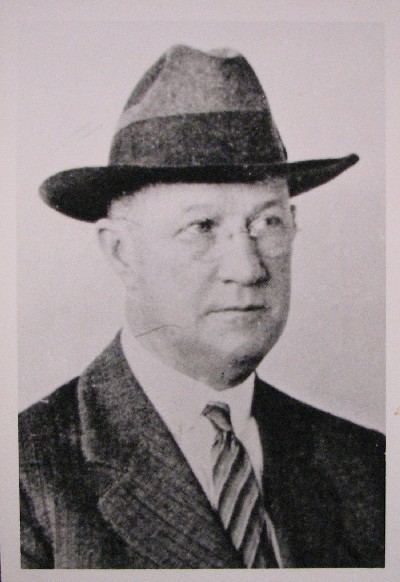 |
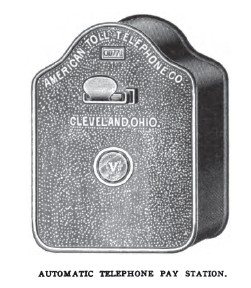 |
Only
a month after start-up, American Toll Telephone Company came out with
their Automatic Telephone Pay Station. The machine could receive nickel
coins and send a buzzer signal to the switchboard operator The
device is purely mechanical, having no electrical connections, and
operating entirely independent of the telephone. It would
capture and record nickels that were fed into the slot, and could
reject slugs and mutilated coins. |
| An
improved version of the pay station soon followed. The new toll box
could accept coins of larger denominations than a nickel.
The
box, which is illustrated herewith, has been adopted by the United
States Telephone Company, and will be installed in a large number of
its long distance pay stations throughout the State of Ohio. Security
was again a key feature of the device and after months of
experimenting, a method is yet to be found of "beating" the device out
of its due receipts. Al Foss spent much of his time representing American Toll Telephone Company at trade shows throughout the country. He would demonstrate the products and look for customers. A new customer was announced in 1902 as The American Toll Telephone Company, Cleveland, Ohio, has just secured a contract for equipping the public stations of the Keystone Telephone Company, Philadelphia, with its three-slot pay stations. Al Foss' American Toll Telephone Company was acquired in 1905 by The Baird Manufacturing Company of Chicago. As we look back over a century later, it is hard to remember that there were once many small, localized phone companies. It is very hard in this day of cell phones to even find a telephone that will accept coins at all. |
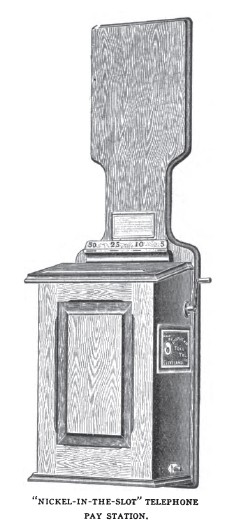 |
Al Foss was operating a second business during much of the time that he was involved with American Toll Telephone Company. The Foss Novelty Company was located at 4 Sheriff Street in Cleveland, Ohio. The Company dealt in selling and servicing second hand cash registers. Foss' cash register business was bought on June 15, 1905 by The National Cash Register Company for the sum of $8,000. Foss Novelty Company was one of nineteen companies bought by NCR between 1893 and 1906. It was been said that NCR acquired those companies that it could not put out of business. Years later, testimony regarding unfair business practices by NCR involving Foss Novelty Company would be heard in a Federal antitrust case. It turns out that NCR had employed a secret agent to operate inside Foss Novelty Company. During the time when Foss Novelty Company was in business one (Mr.) Ellingwood was employed by the National (NCR) to supply inside information as to where that organization (Foss Novelty Company) placed machines, the amount of business which they did, etc. At that time Ellingwood was acting as salesman for the Foss Novelty Company. He was paid a salary of $25 a week by the National (NCR). In February 1911 twenty seven officials of National Cash Register were found guilty on criminal antitrust charges and some were sentenced to jail terms. Though it sold its cash register business, Foss Novelty Company continued operations. A 1911 report by The Ohio Department of Inspection of Workshops, Factories, and Public Buildings showed Foss Novelty Company operating in Cleveland, Ohio in the business of Slot Machines. The Foss Novelty Company Roulette machine is widely sought by today's collectors of antique gaming machines. As mentioned above, Al Foss started a fishing lure company in Cleveland, Ohio in 1915. This time he had no partners or investors. It was just Al Foss, Cleveland, O. The first Al Foss lures were introduced in 1916. More soon followed, as Foss was issued a dozen fishing related patents and the early Al Foss Pork Rind Minnows were based these patents. In addition to lures, Al Foss is known for the unique tin boxes used as packing for the baits, for the development of pork rind trailers, and for selling a high quality fishing reel. |
| Al
Foss retired in 1929, selling his business just before the Depression
to American Fork & Hoe Company of Geneva, Ohio. They
manufactured
Al Foss lures through their True Temper division and expanded the
fishing tackle product line over the next thirty years. True Temper moved their fishing tackle business to South Carolina in the mid 1950's. Several years later they combined several businesses into The American Tackle And Equipment Company, which continued to sell True Temper fishing lures. Production eventually stopped and Weber Tackle of Wisconsin acquired rights to produce the Al Foss Shimmy Wiggler for several years into the late 1960's. Thus, the product line started by Al Foss lasted over fifty years. |
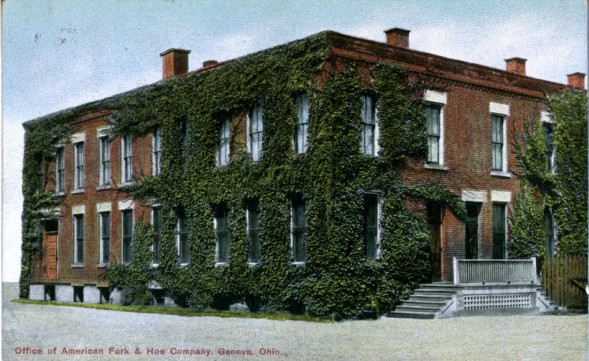 American Fork & Hoe
Company - Geneva, Ohio |
|
Here is a brief
timeline of the major events in the history of the Al Foss Pork Rind
Minnows: |
|
| Al Foss Fishing Tackle in Cleveland, Ohio | 1915 - 1929 |
| Fishing Patents Starting | 1916 |
| Sold to American Fork and Hoe | 1929 |
| True Temper Division Production in Geneva, Ohio | 1929 - 1955 |
| Company became known as True Temper | 1949 |
| Production Moved to Anderson, South Carolina | 1955 |
| True Temper, Montague and Ocean City combined into American Tackle and Equipment Company | 1957 |
| Weber Tackle Company Started Production of Shimmy Wiggler | 1968 |
| After
selling his company, Al Foss retired to Orlando, Florida, where he
spent much of his free time fishing. Florida's largemouth bass had
tugged on Al's line many times before. Ten years earlier he had taken
motion pictures of his fishing adventures in the Sunshine State. Foss
traveled parts of the country showing his film about Florida
Black Bass Fishing and lecturing on bait casting. One of his
good friends and frequent fishing companions was Florida lure maker Jim Pfeffer.
It has been said that when they shared a boat, the only lures on board
were those made by Foss or by Pfeffer. What else could anyone possibly
need? Al Foss was also a tournament caster, and he continued to compete after retirement. Being in Orlando brought him closer to Florida casting friends such as Walter Willman, Tony Acetta, and Earl Gresh. Widely known as the Daddy of Distance Casting, Al Foss helped to organize The Cleveland Casting Club in 1915 and was a Charter Member. The NW Ohio Fish and Game Protective Association awarded the Al Foss Cup at its casting competition for excellence in the standard tackle events. It is interesting to note that lure maker and caster Fred Arbogast was the 1917 winner of the Al Foss Cup. Foss was himself a national champion distance caster in competition of the Association of Scientific Angling and Casting clubs of America. Reflecting upon Foss' championship performance, American Casting Association historian Cliff Netherton wrote that the Distance Bait Event in 1933 is no indication of how great a caster he really was. As scores and records show, Foss won more events and set more unofficial records in distance casting than any of his contemporaries. In 1940 Al Foss was elected President of The National Association of Angling and Casting Clubs. Beyond skill and technique, part of Al Foss' success in distance casting was directly related to the equipment he used. Foss tinkered with and modified numerous casting reels to give better results. A friend recently showed me an early B.F. Meek reel that once belonged to Al Foss. The spool of the reel had been replaced with another, designed and fabricated by Foss. It would have been difficult to recognize the reel if not for the engraving of Meek's name on one side. The other side bore an engraving of the name Al Foss. Other examples of such modified casting reels are known to exist in private collections. Being a successful fisherman and tournament caster, Al Foss brought a great deal of experience to the products he designed. Each was intended to bring the same success to anyone who fished with his Al Foss Pork Rind Minnows. Catalogs and inserts offered advice that customers could use to improve their fishing skills . His baits were easy to cast and weedless. They were reliable and they were effective in catching fish. Moreoever, they were effective in catching fish in a sporting manner. Al Foss frequently scoffed at the piscatorial shrapnel and unsportsmanlike weapons offered up by other lure makers of the day. He spoke of those monstrosities...as only a chunk of wood gaudily painted (to catch the angler) and just bristling with gang hooks (to catch the weeds)..and noted that their design was illegal in some parts of the country. The AL FOSS PORK RIND MINNOWS are not only SPORTSMANLIKE lures, but they will get more game fish than any of those murderous weapons that are called by courtesy "a lure." Weedless, sportsmanlike, easily cast, and not unlawful anywhere...The Sportsman's Lure. Al Foss died on April Fool's day 1949 in Orlando, Florida. He is remembered as a champion in business, in sport, and in life. He is remembered as an innovator, self described as Al Foss - First In Everything. Most of all, he is remembered as a warm and caring man, who was admired, respected, and loved by nearly all who knew him. A friend writing in a 1922 newsletter of NASAC (National Association of Scientific Angling Clubs) said When you arrive at Cleveland, look for Al Foss, see him smile and catch his good humor, after that you will feel perfectly at home, just as if you knew him all your life. |
These are pictures of most of Elizabeth's display of Al Foss and True Temper lures.
Click on the thumbnail images to see a larger picture
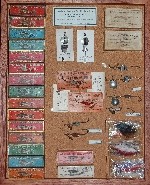 |
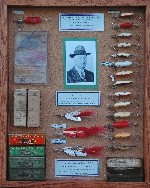 |
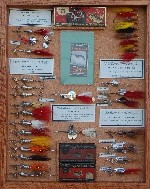 |
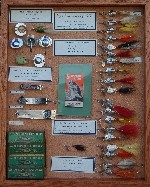 |
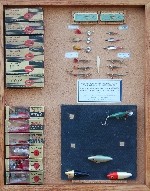 |
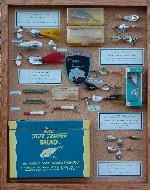 |
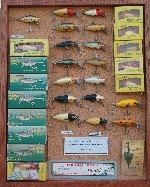 |
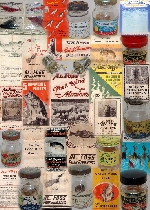 |
We are always interested in adding to this collection. Please let us know if you
have any old or antique Al Foss lures, boxes, or other materials for sale or trade.